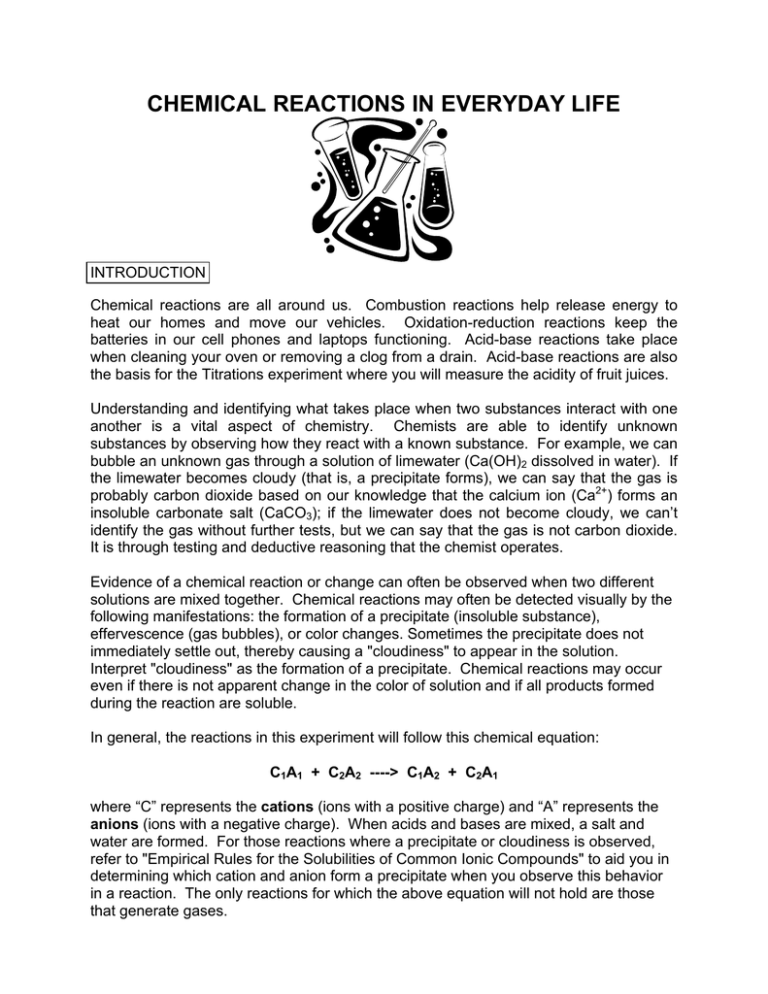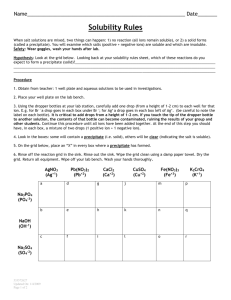CHEMICAL REACTIONS IN EVERYDAY LIFE
advertisement

CHEMICAL REACTIONS IN EVERYDAY LIFE INTRODUCTION Chemical reactions are all around us. Combustion reactions help release energy to heat our homes and move our vehicles. Oxidation-reduction reactions keep the batteries in our cell phones and laptops functioning. Acid-base reactions take place when cleaning your oven or removing a clog from a drain. Acid-base reactions are also the basis for the Titrations experiment where you will measure the acidity of fruit juices. Understanding and identifying what takes place when two substances interact with one another is a vital aspect of chemistry. Chemists are able to identify unknown substances by observing how they react with a known substance. For example, we can bubble an unknown gas through a solution of limewater (Ca(OH)2 dissolved in water). If the limewater becomes cloudy (that is, a precipitate forms), we can say that the gas is probably carbon dioxide based on our knowledge that the calcium ion (Ca2+) forms an insoluble carbonate salt (CaCO3); if the limewater does not become cloudy, we can’t identify the gas without further tests, but we can say that the gas is not carbon dioxide. It is through testing and deductive reasoning that the chemist operates. Evidence of a chemical reaction or change can often be observed when two different solutions are mixed together. Chemical reactions may often be detected visually by the following manifestations: the formation of a precipitate (insoluble substance), effervescence (gas bubbles), or color changes. Sometimes the precipitate does not immediately settle out, thereby causing a "cloudiness" to appear in the solution. Interpret "cloudiness" as the formation of a precipitate. Chemical reactions may occur even if there is not apparent change in the color of solution and if all products formed during the reaction are soluble. In general, the reactions in this experiment will follow this chemical equation: C1A1 + C2A2 ----> C1A2 + C2A1 where “C” represents the cations (ions with a positive charge) and “A” represents the anions (ions with a negative charge). When acids and bases are mixed, a salt and water are formed. For those reactions where a precipitate or cloudiness is observed, refer to "Empirical Rules for the Solubilities of Common Ionic Compounds" to aid you in determining which cation and anion form a precipitate when you observe this behavior in a reaction. The only reactions for which the above equation will not hold are those that generate gases. In today’s experiment, you will be mixing nine different solutions in various combinations and observing what reaction takes place. You will record your observations in a reaction grid and you will be asked to write a balanced chemical equation for each reaction. Once you complete the grid, you will be assigned a household chemical as an unknown. It will be your task to determine what ions are present in your unknown. Use the solubility rules that follow the experimental procedure as additional information in deducing the composition of the unknown solution. A flame test will also be used to help identify the cation in the unknown. You should be able to identify the anion in the unknown solution and propose what the cation(s) would be. SAFETY AND DISPOSAL • • Even though small quantities of chemicals are being used, spills do occur and drops end up on hands. Wash the areas where spills occur with water and wipe with paper towels. When chemicals are spilled on the skin, wash with lots of water to dilute any chemical remaining. The solutions used in this particular lab are to be disposed of in the waste container labeled “Heavy Metals”. The waste container will be located on the center bench near the chemicals. EXPERIMENTAL PROCEDURE I. Reaction Grid Attached is a reaction grid. Record your observations in the boxes provided. Using about 2-3 drops of each reactant, complete each of the reactions indicated in the grid. Make sure to use only CLEAN plastic wells! Some mixtures do not react instantaneously and some do require mixing via swirling or shaking. Complete the equations on the following pages. Be as descriptive as possible with your observations! For instance, do not simply record that a precipitate formed, but rather a cloudy white precipitate. Below are some abbreviations you might wish to use. NO RXN - No observable reaction occurred PPT - Precipitate C - Cloudy EFF - Effervescence (bubbles) Once you have finished all the reactions for the compound at the top of Column #2, move on to the compound listed at the top of Column #3 and then Column #4 and so on until the grid is completed. There are a lot of things to do so stay "on task" to complete all tasks within the given amount of time. II. Unknown Analysis 1. You and your lab partner will be assigned an unknown. Record the substance you have been assigned as an unknown in the space provided. 2. Using only CLEAN test tubes or plastic wells, mix a 2-3 drop portion of the unknown solution with a 2-3 drop potion of each of the nine known solutions and record your observations. Test your unknown with phenolphthalein to determine if it is acidic or basic. Again, be as descriptive as possible. 3. Test your unknown using the flame test to determine the cation of your unknown. The flame test will be set up in the hood. Dip the labeled wire loop into your corresponding unknown solution to obtain a film in the loop. Hold the loop in the flame and observe the color of the flame. Record your observations. Compare the color of the flame to the observations made using known salt solutions. 4. Compare your unknown observations to the observations recorded onthe reaction grid and those observations from the flame test to make some conclusions about what cation and anion is present in your unknown. This will require some deductive reasoning on your part. The answer may not be clear cut for all of the unknowns! EMPIRICAL RULES FOR THE SOLUBILITY OF COMMON IONS Soluble Compounds Exceptions Sodium (Na+), potassium (K+), ammonium (NH4+), acetate (C2H3O2-), and nitrate (NO3-) containing compounds. Halides (chlorides (Cl-) bromides (Br-), and iodides (I-)) Lead (II)(Pb2+), silver (Ag+) and mercury (I)(Hg22+) halides are insoluble Sulfates (SO42-) Calcium (Ca2+), strontium (Sr2+), barium (Ba2+), and lead (II) (Pb2+) sulfates are insoluble Insoluble Compounds Exceptions Carbonates (CO32-) and phosphates (PO43-) Sodium (Na+), potassium (K+), and, ammonium (NH4+) compounds are soluble Hydroxides (OH-) Sodium (Na+), potassium (K+), barium (Ba2+), strontium (Sr2+), and ammonium (NH4+) hydroxides are soluble. Calcium (Ca2+) hydroxides are slightly soluble. Sulfides (S2-) Sodium (Na+), potassium (K+), calcium (Ca2+), and ammonium (NH4+) sulfides are soluble. CHEMICAL REACTIONS: REACTION GRID COLUMN #1 Indicator column Phenolphthalein COLUMN #2 H2SO4 COLUMN #3 (NH4)2CO3 COLUMN #4 HCl COLUMN #5 ZnSO4 COLUMN #6 NaHPO4 NH3 KOH BaCl2 AgNO3 NaHPO4 ZnSO4 HCl (NH4)2CO3 H2SO4 OBSERVATIONS FROM FLAME TEST Salt Color of Emission COLUMN #7 AgNO3 COLUMN #8 BaCl2 COLUMN #9 KOH



